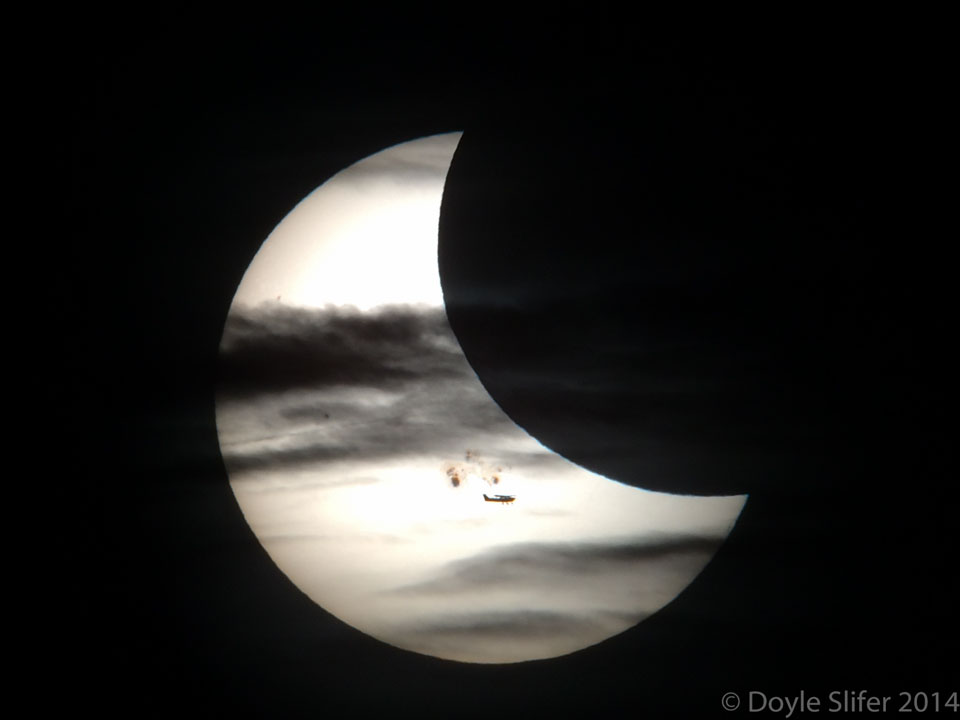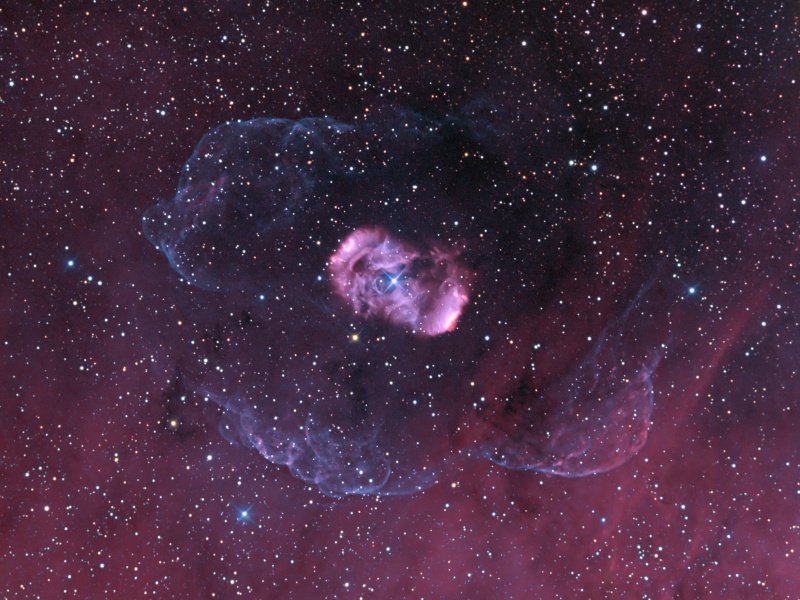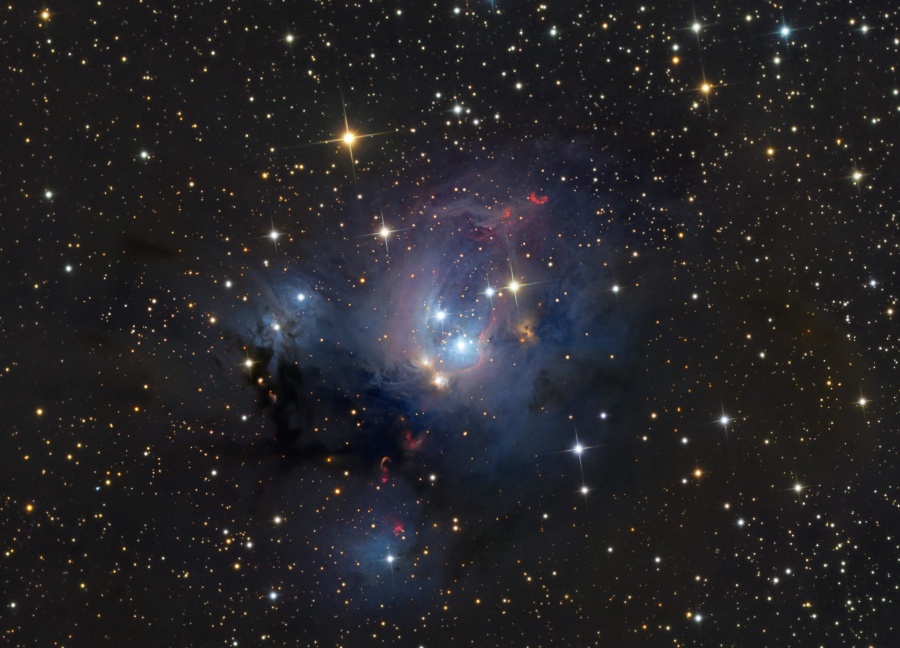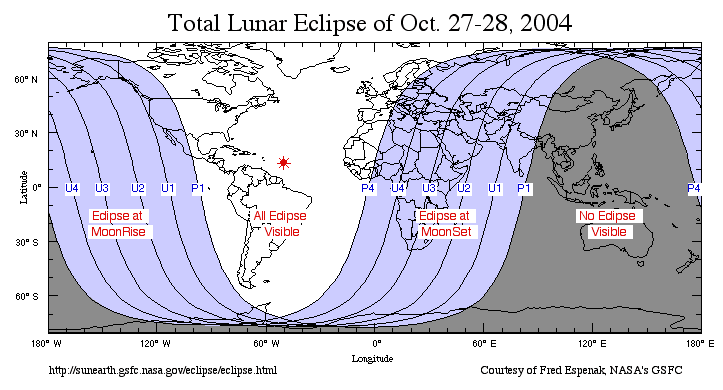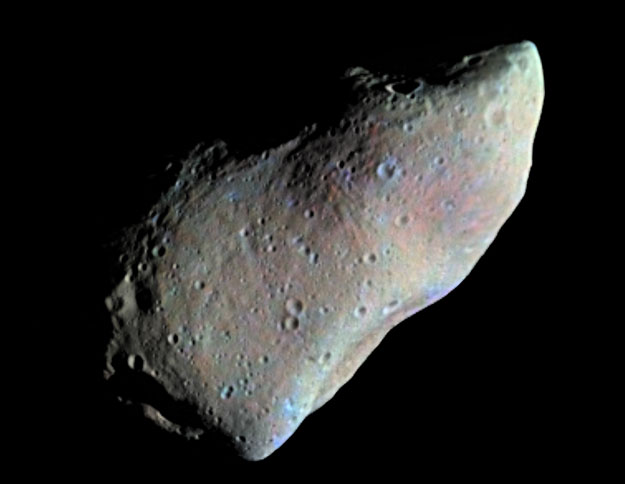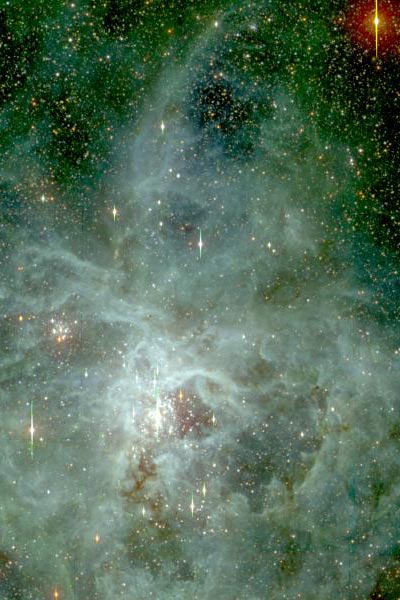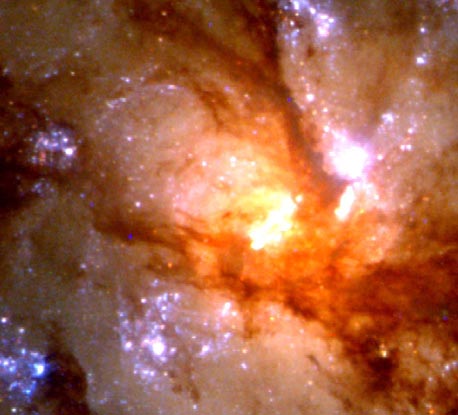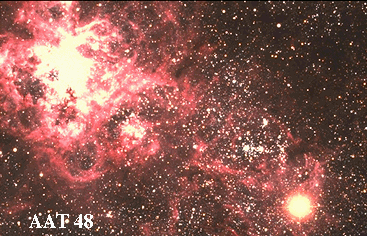| << Previous | Index | Next >> |
2014 What's that in front of the Sun? The closest object is an airplane, visible just below the Sun's center and caught purely by chance. Next out are numerous clouds in Earth's atmosphere, creating a series of darkened horizontal streaks. Farther out is Earth's Moon, seen as the large dark circular bite on the upper right. Just above the airplane and just below the Sun's surface are sunspots. The main sunspot group captured here, AR 2192, is one of the largest ever recorded and has been crackling and bursting with flares since it came around the edge of the Sun early last week. Taken last Thursday, this show of solar silhouettes was unfortunately short-lived. Within a few seconds the plane flew away. Within a few minutes the clouds drifted off. Within a few hours the partial solar eclipse of the Sun by the Moon was over. Only the sunspot group remains, but within a few more days even AR 2192 will disappear around the edge of the Sun. Fortunately, when it comes to the Sun, even unexpected alignments are surprisingly frequent.
2013 Arcing toward a fiery fate, this Sungrazer comet was recorded by the SOHO spacecraft's Large Angle Spectrometric COronagraph(LASCO) on December 23, 1996. LASCO uses an occulting disk, partially visible at the lower right, to block out the otherwise overwhelming solar disk allowing it to image the inner 8 million kilometers of the relatively faint corona. The comet is seen as its coma enters the bright equatorial solar wind region (oriented vertically). Positioned in space to continuously observe the Sun, SOHO has now been used to discover over 1,500 comets, including numerous sungrazers. Based on their orbits, the vast majority of sungrazers are believed to belong to the Kreutz family of sungrazing comets created by successive break ups from a single large parent comet that passed very near the Sun in the twelfth century. The Great Comet of 1965, Ikeya-Seki, was also a member of the Kreutz family, coming within about 650,000 kilometers of the Sun's surface. Passing so close to the Sun, Sungrazers are subjected to destructive tidal forces along with intense solar heat. This small comet, known as the Christmas Comet SOHO 6, did not survive. Later this year, Comet ISON, potentially the brightest sungrazer in recorded history but not a Kreutz sungrazer, is expected to survive.
2012 Beautiful emission nebula NGC 6164 was created by a rare, hot, luminous O-type star, some 40 times as massive as the Sun. Seen at the center of the cosmic cloud, the star is a mere 3 to 4 million years old. In another three to four million years the massive star will end its life in a supernova explosion. Spanning around 4 light-years, the nebula itself has a bipolar symmetry. That makes it similar in appearance to more familiar planetary nebulae - the gaseous shrouds surrounding dying sun-like stars. Also like many planetary nebulae, NGC 6164 has been found to have an extensive, faint halo, revealed in this deep telescopic image of the region. Expanding into the surrounding interstellar medium, the material in the halo is likely from an earlier active phase of the O star. The gorgeous skyscape is a composite of narrow-band image data highlighting the glowing gas, and broad-band data of the surrounding starfield. NGC 6164 is 4,200 light-years away in the southern constellation of Norma.
2011 Young suns still lie within dusty NGC 7129, some 3,000 light-years away toward the royal constellation Cepheus. While these stars are at a relatively tender age, only a few million years old, it is likely that our own Sun formed in a similar stellar nursery some five billion years ago. Most noticeable in the sharp image are the lovely bluish dust clouds that reflect the youthful starlight. But the compact, deep red crescent shapes are also markers of energetic, young stellar objects. Known as Herbig-Haro objects, their shape and color is characteristic of glowing hydrogen gas shocked by jets streaming away from newborn stars. Paler, extended filaments of reddish emission mingling with the bluish clouds are caused by dust grains effectively converting the invisible ultraviolet starlight to visible red light through photoluminesence. Ultimately the natal gas and dust in the region will be dispersed, the stars drifting apart as the loose cluster orbits the center of the Galaxy. At the estimated distance of NGC 7129, this telescopic view spans about 40 light-years.
2010
[imghover6=http://apod.nasa.gov/apod/image/0909/UV ... ftH600.jpg]http://apod.nasa.gov/apod/image/0909/Op ... a_h600.jpg[/imghover6]Credit: UV - NASA/Swift/Stefan Immler (GSFC) and Erin Grand (UMCP)
Optical - Bill Schoening, Vanessa Harvey/REU program/NOAO/AURA/NSF
Optical - Bill Schoening, Vanessa Harvey/REU program/NOAO/AURA/NSF
2009 In cosmic brush strokes of glowing hydrogen gas, this beautiful skyscape unfolds across the plane of our Milky Way Galaxy and the center of the northern constellation Cygnus the Swan. Recorded from a premier remote observatory site (ROSA) in southern France, the image spans about 6 degrees. Bright supergiant star Gamma Cygni near image center lies in the foreground of the complex gas and dust clouds and crowded star fields. Left of Gamma Cygni, shaped like two luminous wings divided by a long dark dust lane is IC 1318, whose popular name is understandably the Butterfly Nebula. The more compact, bright nebula at the lower right is NGC 6888, the Crescent Nebula. Some distance estimates for Gamma Cygni place it at around 750 light-years while estimates for IC 1318 and NGC 6888 range from 2,000 to 5,000 light-years.
2008 What clouds lurk beneath Saturn's unusual South Pole? To help find out, the robotic Cassini spacecraft currently orbiting Saturn imaged the nether region of the gigantic ringed orb in infrared light. There thick clouds appear dark as they mask much of the infrared light emitted from warmer regions below, while relatively thin clouds appear much lighter. Bands of clouds circle Saturn at several latitudes, while dark ovals indicate many dark swirling storm systems. Surprisingly, a haze of upper level clouds visible towards Saturn's equator disappears near the pole, including over Saturn's strange polar vortex. Cassini entered orbit around Saturn in 2004, and recorded the above image last year.
2007 A jewel of the southern sky, the Great Carina Nebula, aka NGC 3372, spans over 300 light-years, one of our galaxy's largest star forming regions. Like the smaller, more northerly Orion Nebula, the Carina Nebula is easily visible to the naked eye, though at a distance of 7,500 light-years it is some 5 times farther away. This stunning telescopic view reveals remarkable details of the region's glowing filaments of interstellar gas and dark cosmic dust clouds. The Carina Nebula is home to young, extremely massive stars, including the still enigmatic variable Eta Carinae, a star with well over 100 times the mass of the Sun. Eta Carinae is the bright star left of the central dark notch in this field and just below the dusty Keyhole Nebula (NGC 3324).
2006 Star clusters and nebulae abound in the ancient northern constellation Auriga - a region that includes the interesting pair NGC 1931 (lower left) and IC 417. In this gorgeous color image, an imaginative eye toward the expansive IC 417 and diminutive NGC 1931 suggests a cosmic spider and fly. About 10,000 light-years distant, both are young open star clusters formed in interstellar clouds and still embedded in glowing hydrogen gas. The more compact NGC 1931 is about 10 light-years across with contrasting blue hues characteristic of dust reflected starlight.
2005 On October 19th, a rocket blasted off from Vandenberg Air Force Base - the last Titan rocket. Carrying a payload for the US National Reconnaissance Office, the successful Titan IV B launch brings to a close the Titan program whose first launch was in 1959. Originally designed as an intercontinental ballistic missile, the Titan rocket ultimately evolved into a heavy lift workhorse, launching defense, commercial, and scientific payloads to Earth orbit and beyond. In fact, many historic space explorations began with Titan launches, including manned Gemini missions, the Viking missions to Mars, the Voyager tours of the outer solar system, and the Cassini spacecraft now orbiting Saturn. Cassini's probe Huygens accomplished the most distant landing on another world, while Voyager 1 is now humanity's most distant spacecraft.
2004 Go outside tonight and see the total lunar eclipse. Tonight's eclipse is easy and convenient for much of the world to see. Anyone who can spot a full Moon can see it fade out as the Earth's shadow engulfs it. No protective glasses or expensive telescopes are needed, just a little moxie. The above illustration shows how the eclipse will appear across the Earth. The total lunar eclipse starts at 9:14 pm Eastern Daylight Time, equivalent to 1:14 am UT in the morning for sky enthusiasts in the United Kingdom. From the moment the first part of the Moon disappears to the moment that the last part of the Moon reappears will be 3 hours and 40 minutes. For those unfortunate enough to suffer clouds, the eclipse can also be followed over several live webcasts.
2003 Two unusually large sunspot groups are now crossing the face of the Sun. Each group, roughly the size of Jupiter, is unusual not only for its size but because it is appearing over three years after solar maximum, the peak of solar surface activity. Sunspot group 10484 appears near the image center, while sunspot group 10486 is just coming over the left limb of the Sun. The active region associated with Sunspot 484 (the shorter nickname) has already jettisoned a large coronal mass ejection (CME) of particles out into the Solar System. When striking Earth, radiation of this sort has the power to interrupt normal satellite operations while simultaneously providing beautiful auroras. Rotating with the Sun, sunspots 484 and 486 will take about 30 days to make one complete circle, slowly evolving in size and shape during this time. After using extreme care never to look directly at the Sun, the above image was created by holding a digital camera up to a small telescope.
2002 Asteroid 951 Gaspra is a huge rock tumbling in space. Gaspra became one of the best-studied asteroids in 1991 when the spacecraft Galileo flew by. In the above photograph, subtle color variations have been exaggerated to highlight changes in reflectivity, surface structure and composition. Gaspra is about 20 kilometers long and orbits the Sun in the main asteroid belt between Mars and Jupiter.
2001 No supernova has ever been predicted. These dramatic stellar explosions that destroy stars and disperse elements that compose people and planets are not so well understood that astronomers can accurately predict when a star will explode - yet. Perhaps Sher 25 will be the first. Sher 25, designated by the arrow, is a blue supergiant star located just outside the star cluster and emission nebula NGC 3603. Sher 25 lies in the center of an hourglass shaped nebula much like the one that surrounds the last bright supernova visible from Earth: SN1987a. Now the hourglass shaped rings around SN1987a were emitted before that blue supergiant exploded. Maybe Sher 25 has expelled these bipolar rings in a step that closely precedes a supernova. If so, Sher 25 may be within a few thousand years of its spectacular finale.
2000 Scroll right and fly close over asteroid Eros! This long mosaic was constructed of images returned yesterday by the NEAR Shoemaker spacecraft as it orbited to within 6.4 kilometers of a spot in the southern hemisphere of the rotating asteroid's surface. That distance (about 21,000 feet) is less than the cruising altitude of most commercial airline flights. The digital images show that while many regions appear smooth with craters filled in by an accumulation of loose regolith, much of Eros' surface is littered with rocks and boulders. The large boulder glinting in the sunlight at the far left, just above the center of the mosaic, spans approximately 25 meters. In the high-resolution view, the smallest rocks visible are roughly human-sized at about 1.4 meters (5 feet) across. The car-sized Near Shoemaker spacecraft is now on its way to a higher, more stable orbit about 200 kilometers above asteroid Eros.
1999 In the heart of monstrous Tarantula Nebula lies one of the most unusual star clusters. Known as NGC 2070 or R136, it is home to a great number of hot young stars. The energetic light from these stars continually ionizes nebula gas, while their energetic particle wind blows bubbles and defines intricate filaments. The above representative-color picture of this great LMC cluster details its tumultuous center in gas, dust and young stars. The 30 Doradus nebula is one of the largest star-formation regions known, and has been creating unusually strong episodes of star formation every few million years. In the heart of this heart is a central knot of stars that is so dense it was once thought to be a single star.
1998 Humanity's understanding of the relative brightness and variability of stars was revolutionized by the work of Henrietta Swan Leavitt (1868-1921). Working at Harvard College Observatory, Leavitt precisely calibrated the photographic magnitudes of 47 stars to which all other stars could be compared. Leavitt discovered and cataloged over 1500 variable stars in the nearby Magellanic Clouds. From this catalog, Leavitt discovered that brighter Cepheid variable stars take longer to vary, a fact used today to calibrate the distance scale of our universe.
1997 It's a clash of the titans. Two galaxies are squaring off in Corvus and here are the latest pictures. When two galaxies collide, however, the stars that compose them usually do not. This is because galaxies are mostly empty space and, however bright, stars only take up only a small amount of that space. But during the slow, hundred million year collision, one galaxy can rip the other apart gravitationally, and dust and gas common to both galaxies does collide. In the above wreckage, dark dust pillars mark massive molecular clouds, which are being compressed during the galactic encounter, causing the rapid birth of millions of stars.
1996 Why is Io green at night? In this just-released nighttime picture of Jupiter's moon Io, the red spots clearly show Io's current volcanically active regions. But what is causing the global green sheen? This telling picture was taken by the automated Galileo spacecraft currently orbiting Jupiter while Io was in Jupiter's shadow. One hypothesis is that the green glow is caused by a different type of aurora resulting from high-energy particles interacting with Io's volcanic plumes.
1995
| << Previous | Index | Next >> |
